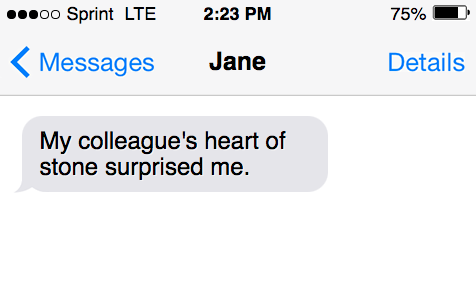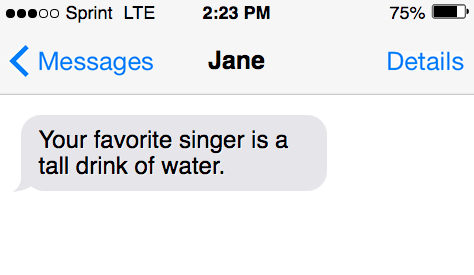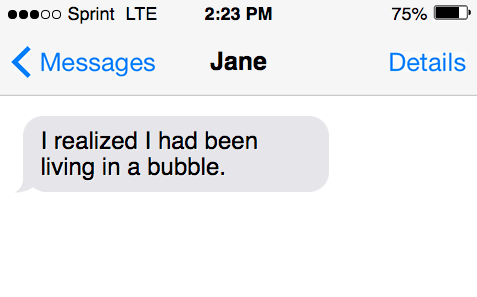A metaphor is a complex and beautiful way the English language can get used to communicate deep ideas or intentions. Metaphors give comparisons between two parallel text. And often allow us to comprehend objects, things, concepts, thoughts, and ideas in more robust manners due to the way it gets compared.
Let’s learn about metaphors and how they get used in the English language…
What is a metaphor?
A metaphor is a figure of speech that compares two things that are not the same. A metaphor is a way to compare two things and say they are the same, not just similar.
This means that in a metaphor, words or phrases usually used to talk about one thing or idea are used to talk about something else that isn’t traditionally associated with that language.
| Metaphor example | Metaphor words |
| The sun was a gleaming pearl. | Sun, gleaming, pearl. |
| My baby brother is a cute little teddy bear. | Brother, cute little teddy bear. |
| The car seat is a fluffy cloud. | Car seat, fluffy cloud. |
Examples of metaphors in literature
- “The sun was a toddler insistently refusing to go to bed. It was past eight-thirty and still light.” – John Green; The Fault In Our Stars
- “The frosted wedding cake of the ceiling” – F. Scott Fitzgerald; The Great Gatsby
- “I’m a riddle in nine syllables” – Sylvia Plath; Metaphors
- “Hope is the thing with feathers” – Emily Dickinson; Hope
- “Behind him, sitting on piles of scrap and rubble, was the blue kite. My key to Baba’s heart.” – Khaled Hosseini; The Kite Runner

Examples of metaphors in songs
- Third floor on the West Side, me and you; Handsome, you’re a mansion with a view – Taylor Swift; Delicate
- Say you want me out of your life; And I’m just a dead man walking tonight – 5 Seconds of Summer; Young Blood
- Don’t you tell me what you think that I can be; I’m the one at the sail, I’m the master of my sea – Imagine Dragons; Believer
- Michelle Pfeiffer, that white gold; This one for them hood girls; Them good girls, straight masterpieces – Mark Ronson ft. Bruno Mars; Uptown Funk
- Cause baby you’re a firework – Katy Perry; Firework
Examples of metaphors in idioms
- My best friend is a walking disaster.
- Her sister was an angel incarnate.
- It rained cats and dogs last week.
- The queen swallowed her pride when the knight raised questions.
- He advised me to either bite the bullet or give it my best shot.
Learn about metaphor in this video lesson
Difference between metaphor and simile
When compared side by side to literary tropes, metaphors and similes can often be challenging to differentiate from one another. Both of these are examples of figures of speech that are used to make comparisons. Simile belongs to the category of metaphor.
However, they are differentiated by using either “like” or “as” as the connecting word. Metaphors are a way to draw direct comparisons without utilizing the terms being compared. Comparisons may be made using similes by utilizing the phrase “like” or “as.”
A metaphor is a more direct comparison (one thing is another), making it a somewhat more convincing overall argument. You should employ metaphors to drive home the point that the two items are comparable.
| Word | Definition |
| Metaphor (noun) /ˈmedəˌfôr,ˈmedəˌfər/ | a figure of speech in which a word or phrase is applied to an object or action to which it is not literally applicable. |
| Simile (noun) /ˈsiməlē/ | a figure of speech involving the comparison of one thing with another thing of a different kind, used to make a description more emphatic or vivid (e.g., as brave as a lion, crazy like a fox ). |
| Analogy (noun) /əˈnaləjē/ | a comparison between two things, typically for the purpose of explanation or clarification. |
Understanding simile
On the other hand, a simile functions more like a suggestion than anything else. However, the text continues even after the image has been implanted in the reader’s mind. Similes are the way to go when you want to describe something but don’t want the reader to linger too long on it.
Scale is another important consideration when working with metaphors and similes. While metaphors can extend over a whole piece of writing, similes can only be used within the confines of a single line.
For instance, there are thousands of interpretations of what the film “The Matrix” is supposed to be a metaphor for. It is not very rare that you will hear someone describe a finished product as a metaphor for anything else. That would need a significant number of “likes.”
Difference between metaphor and analogy
Literary devices, such as metaphors and analogies, are tools that may be used to cement a concept in the mind of a reader. Because a metaphor is a figure of speech and an analogy is a logical argument, their applications are quite distinct from one another.
Figurative language in literature often takes the form of metaphors. A word or phrase is usually employed as a representation to create a more dramatic impression. To put it another way, the term or phrase in question refers to an item to imply a connection that is not literal.
An analogy may be used to create a logical argument by comparing two different items to convey a point. In contrast to a metaphor, a figure of speech that involves figurative language and allows one object to stand in for another, an analogy is an attempt to describe something.
Difference between metaphor and metonymy
There are many ways in which metonymy and metaphor are comparable; nonetheless, the primary distinction between the two is that whereas a metaphor replaces one idea with another, a metonymy chooses a related term.
Therefore, if metonymy refers to the association, then metaphor refers to substitution.
As an illustration, “my brother is a tiger in class” is an example of a metaphor. In this context, expressing a particular aspect of a person’s character is represented by the term “tiger,” an animal.
Understanding metonymy
Metonymy may be seen in the sentence, “the tiger called his pals to the playground.” In this case, there is no substitute; rather, the individual is compared to a tiger due to his characteristics.
One other distinction that can be made between metonymy and metaphor is that metonymy works by mixing concepts, but metaphor works by excluding ideas from consideration.
However, in the world of the psychological, metaphor and metonymy are both utilized for communicating thoughts that are significantly distinct from the original meaning of the words.
When someone uses a metonymy, the attributes associated with the original term are not carried over to the metonymy. On the other hand, in metaphor, when there is a comparison, it is based on the traits, and in the process, certain qualities are transferred from the original to the metaphor.
Synonyms for Metaphor
- Analogy
- Emblem
- Symbol
- Similitude
- Image
- Trope
- Metonymy
- Personification
- Allegory
Understanding metaphor, simile, personification, hyperbole
Here are the key differences between metaphor, simile, personification, and hyperbole.
Metaphor example
- My colleague’s heart of stone surprised me.
- My husband is buried in a sea of paperwork.
- Your favorite singer is a tall drink of water.
- The contest winner had stars in her eyes.
- I realized I had been living in a bubble.
Simile example
- The new doll she gifted me was as cute as a kitten.
- This neon dress is as bright as a button.
- My new badge is as shiny as a new pin.
- This garage is as big as a house.
- Your sister is as innocent as a dove.
Personification example
- The sun smiled down on the new parents.
- New York is a city that never sleeps.
- The noise coming from the storm was as loud as the howling wind.
- I wish he understood that actions speak louder than words.
- His old and battered car wouldn’t quit.
Hyperbole example
- He was so hungry, he could eat a horse.
- She may be old but she can hear a pin drop a mile away.
- The story made him die of embarrassment.
- My old colleague was as skinny as a toothpick.
- It was raining cats and dogs at the stadium.
Understanding the various types of metaphors
Let’s understand the various types of metaphors.
Implied metaphor
Comparing two dissimilar items that do not name either is called an implied metaphor.
A direct metaphor is comprised of two parts: the tenor, which is the original thought, and the vehicle, which is the notion that is being compared.
While an implied metaphor does not include the tenor, a direct metaphor includes.
Example
- The waiter fetched food for the impatient customers.
- The host hopped from one end to the other, talking to his guests.
- I never thought I could sail through the final exams with such great numbers.
- The air has been growing older with each passing day.
Sustained metaphor
A sustained metaphor, also known as an extended metaphor, is when an author uses one metaphor or simile again and at length across a poem or tale by linking numerous tenors, vehicles, and grounds together. This type of metaphor is also known as an extended metaphor.
It is frequently used to describe a complicated concept, giving readers or listeners the ability to picture the concept using terminology that they are already familiar with.
Example
- My friend is such a snake. Everything he hisses out of his mouth is cruel. He frightens all those around him and has no spine.
- My sister is a mama bear. She protects everyone like they are her own children. We feel safe around her.
Dead metaphor
A metaphor is said to be dead when used so frequently, repeatedly, and extensively that the original picture associated with its meaning has been forgotten.
It is not necessary to be familiar with the original connotation of a dead metaphor to comprehend its current meaning because the customary meaning of a dead metaphor differs from the original.
Literalization of a metaphor refers to the process by which a metaphor loses its original meaning over time due to semantic changes that occur naturally in the development of a language.
Example
- My mother has a heart of gold.
- It was raining cats and dogs at the cricket stadium with his sixes.
Mixed metaphors
When two or more metaphors that cannot work together are combined into one metaphor, the result is known as a mixed metaphor.
This method often referred to as a “mixaphor,” can be utilized by characters in one of two distinct ways. It would be used purposefully or unintentionally, depending on the context of the conversation.
To put it another way, a character might provide the impression of wit if they are aware of the fact that they are mixing two sentences. They could become uneducated even when all they need is the necessary knowledge.
Examples
- We need to get all our dogs on the same page.
- Napolean also had his Watergate.
Conceptual metaphors
In the field of cognitive linguistics, the comprehension of one notion or conceptual domain in terms of another is referred to as conceptual metaphor, which is also shortened to cognitive metaphor.
Any mental structure of human experience can constitute a conceptual domain. It has been hypothesized that the mapping across conceptual domains correlates to neural mappings in the brain due to the consistency with which many languages use the same metaphors.
These metaphors are frequently based on perceptual similarities. This hypothesis has garnered a lot of attention, even though several scholars have doubts about how accurate its empirical claims are.
Examples
“Time is money”
- What do you do to spend your time?
- Yesterday’s flat tire cost me the whole day.
- I have invested a lot of time in this project.
- You are running out of time to complete this project.
How to develop and write a metaphor
Your creativity and imagination may run wild when you use metaphors. The following are some measures that you may take to help you develop an excellent metaphor:
1. Decide on a person, thing, or place to write about.
Take for instance, that you are going to compose a metaphor about a goalkeeper for a soccer game. What are some of the features that define a goalie? The goaltender needs to have a strong mentality when facing the opposing offense.
Goalies are supposed to act as a barrier that prevents opponents from scoring. Imagine your character, item, or scene using all of your senses as you think about them. This can help you create a more vivid mental image (e.g., sound, sight, smell, etc.).
2. Concentrate on the specific situation you’re expressing.
Determine the features that it possesses. Imagine that our goaltender competes in the final game against his most feared opponent.
And let’s assume this foe is a physically imposing figure of great size. How should I interpret the tone that you’re going for here? When you are describing the situation, keep this fact in mind.
3. Now, think of some more things that have the same qualities as the ones you found in the first step.
Always keep in mind how the particular circumstance reflects on your character. Is it like David taking on Goliath in our goaltender situation? No, that has been attempted way too many times before.
Perhaps the goaltender is analogous to a young seal being pursued by a dangerous shark as it gets closer and closer. That’s not the kind of person we want our goaltender to be, so we can’t have him doing that. We want him to be unshakeable when confronted with his adversary.
What about the goaltender being compared to the uncharted depths of the ocean? This may provide you with many ideas for your goalie’s character, particularly his more profound thoughts, and ideals.
4. Take your existing metaphor and develop it further.
It is not sufficient to just compare the goaltender to the ocean deep; highlight it in a way that goes beyond a single phrase to generate an image that fully encompasses the specific features.
Techniques for writing using metaphors
Here are techniques for writing metaphors.
1. By dismissing your initial ideas, you may steer clear of cliches.
When it comes to creating metaphors, you should get in the habit of dismissing the first notion that comes to mind. It’s usually the first thing that comes to mind since it compares to something you’re already familiar with.
And if it’s not foreign to you, there’s a good chance that it won’t be to your readers either. Keep in mind that the brain enjoys being surprised the most.
The phrases “armed to the teeth,” “bad to the bone,” “burning passion,” “turn a blind eye,” “the crack of dawn,” “hammering heart,” “bite the bullet,” “heart of gold,” and “blood flowing cold” are all examples of tired metaphors.
2. Think about the character and environment from your point of view.
Check to be if the analogy or comparison you’re employing in your metaphor is something that your perspective character is already familiar with. This is an excellent method for developing one’s persona as well as one’s voice.
For instance, if your character is a cook, you may use metaphors that involve food, such as “his face was a mangled platter of ham,” “she felt the singe of remorse,” or “blueberry bruises marred his flesh.”
Remember to consider the location and era of your story as well. If the setting of your story is Ancient Rome, you shouldn’t use metaphors like “the bowler-hat cave” because I’m sure people didn’t wear bowler hats back then.

3. Avoid blending the analogies.
A mixed metaphor is simply when you use two pictures not linked to one another to depict the same thing, thereby illogically merging different ideas or imagery.
When you do this, you weaken the power of both metaphors because the reader is forced to exert effort to distinguish between the aspects of the two pictures that are being compared. As an illustration, you may say, “If we want to go ahead, we’ll need to iron out the remaining bottlenecks.”
You will have a much easier time avoiding mixed metaphors if you watch for tired metaphors. We can be so used to cliché metaphors that we don’t even recognize them, making it simple to confuse them with another metaphor by accident.

4. Keep your creative fires burning.
Your imagination will be put to the test as you write metaphors. To create beautiful, original, and compelling metaphors, you must draw deeply from your own experiences.
Think about the particular image or sensation you are attempting to convey, and then think of a time in your life when you felt or recognized that image or feeling to the fullest extent.
5. When you’re reading literature, keep an eye out for analogies. Better still, read poetry.
The imagery and metaphorical language found in poetry are abundant. Reading it will condition your brain to think in this manner; the more you read, the better you’ll be able to conjure up sophisticated metaphors, and that’s a promise.

How do you recognize a metaphor in four easy steps?
Some metaphors, such as those employed in day-to-day conversation, are very easy to recognize. Finding the right one among the others might be challenging but not impossible.
Applying this straightforward, 4-step methodology can help you recognize metaphors from a mile away:
1. Smell a comparison
In the realm of comparison, each of the three figurative language devices has its place—the simile, the analogy, and the metaphor.
Therefore, the first thing you need to do to recognize a metaphor is to recognize a parallel in the text. You can tell you are in the company of a comparison literary device if there is at least one of them present.
2. Determine whether the comparison requires the use of crutches.
Similes rely on assistance. To make comparisons, they frequently use the phrases “like” and “as.” If you come across such crutches, you may deduce that the expression in question is a simile, not a metaphor.

3. Put it via the monitor that analyzes explanations.
Now that you’ve reduced your choices to just two—metaphor vs. analogy—you need to differentiate between the two. How? by taking into consideration how thoroughly the comparison is conveyed.
An analogy is a literary technique used when the author takes the time to demonstrate how two concepts are comparable to one another.
4. Examine the allegory through the lens of a microscope
You should realize by this point that the image in front of you is a metaphor. Therefore, the final phase in the framework is to dissect the metaphor and conduct an examination of the substance.

How do metaphors organize themselves?
The framework of a metaphor is comprised of the following four components:
1. Vehicle
The term “vehicle” refers to the word that is responsible for conveying the metaphor’s meaning. In the previous illustration, “Your response is crystal obvious,” the word “crystal” serves as the carrier.
2. Tenor
What is being communicated; is the fact that the response may be grasped readily.
3. Ground
The basis for comparison is the relationship between two or more objects. The response, like the crystal, possesses an attribute known as transparency, also known as ground. The basis for their comparison is the degree to which they are clear.
4. Tension
The space that exists between the items is known as tension. The answer itself is not a crystal, unless you are at a gem exhibition, in which case you may be talking about a pun. However, the answer is not a crystal if you are not at a gem show.
FAQs
Common questions asked about metaphors.
What is a metaphor?
A comparison of two things that asserts that one thing is the other is what we refer to as a metaphor. As an illustration, he is a complete bore.
How are similes and metaphors distinct from one another?
Comparisons made using a simile are made indirectly using the words “like” or “as.” Direct parallels, sometimes known as metaphors, indicate that one thing is another.
The most comprehensive of the two concepts is metaphor, which may be defined as any comparison, from single lines to complete works of literature. The use of similes is restricted to sentences.
How exactly does one go about writing a good metaphor?
The most effective use of metaphors is to tie seemingly intangible ideas to concrete examples that the audience is already familiar with and can quickly grasp.
What is an extended metaphor?
An extended metaphor is one that goes on for several sentences.
What is a dead metaphor? And how can it go unnoticed?
If the audience does not need to visualize the action; dead metaphors typically go unnoticed.
Conclusion
Here’s how we can conclude.
Metaphors make sense
The world that we live in is imbued with meaning via metaphors. Thanks to their insight, they enable us to make sense of even the most complicated concepts.
We are fortunate to have metaphors as a means of communication because our environment may sometimes be rather challenging to comprehend.
The internet can be compared to a cloud, love can be compared to a battlefield, and time can be compared to money. Aren’t metaphors just a little bit magical?

Sources
- What’s the Difference Between Metaphor, Simile, and Analogy?
- Metaphor, Simile, and Analogy: What’s the Difference?
- How to Write Powerful Metaphors
- Making up metaphors
- What is a Metaphor?
- Conceptual metaphor
- Understanding Conceptual Metaphors
- What is a Mixed Metaphor — Definition & Examples for Writers
- Extended Metaphor: Meaning, Structure, Examples, How To Use
- Metaphor Examples: Understanding Meaning and Purpose
- Metaphors
- Examples of Metaphors in Literature
- 20 Examples of Metaphors in Popular Songs
- 16 Metaphors, Idioms and Similes for Easy
- ‘Metaphor’ vs. ‘Simile’
- Idioms vs Metaphors in the digital world
- Simile vs. Metaphor: What’s the Difference?
- Difference Between Metaphor and Metonymy
- What is Personification — Definition and Examples for Writers
- Implied Metaphor — Definition, Purpose, & Examples
Inside this article
Fact checked:
Content is rigorously reviewed by a team of qualified and experienced fact checkers. Fact checkers review articles for factual accuracy, relevance, and timeliness. Learn more.
Core lessons
Glossary
- Abstract Noun
- Accusative Case
- Anecdote
- Antonym
- Active Sentence
- Adverb
- Adjective
- Allegory
- Alliteration
- Adjective Clause
- Adjective Phrase
- Ampersand
- Anastrophe
- Adverbial Clause
- Appositive Phrase
- Clause
- Compound Adjective
- Complex Sentence
- Compound Words
- Compound Predicate
- Common Noun
- Comparative Adjective
- Comparative and Superlative
- Compound Noun
- Compound Subject
- Compound Sentence
- Copular Verb
- Collective Noun
- Colloquialism
- Conciseness
- Consonance
- Conditional
- Concrete Noun
- Conjunction
- Conjugation
- Conditional Sentence
- Comma Splice
- Correlative Conjunction
- Coordinating Conjunction
- Coordinate Adjective
- Cumulative Adjective
- Dative Case
- Determiner
- Declarative Sentence
- Declarative Statement
- Direct Object Pronoun
- Direct Object
- Diction
- Diphthong
- Dangling Modifier
- Demonstrative Pronoun
- Demonstrative Adjective
- Direct Characterization
- Definite Article
- Doublespeak
- False Dilemma Fallacy
- Future Perfect Progressive
- Future Simple
- Future Perfect Continuous
- Future Perfect
- First Conditional
- Irregular Adjective
- Irregular Verb
- Imperative Sentence
- Indefinite Article
- Intransitive Verb
- Introductory Phrase
- Indefinite Pronoun
- Indirect Characterization
- Interrogative Sentence
- Intensive Pronoun
- Inanimate Object
- Indefinite Tense
- Infinitive Phrase
- Interjection
- Intensifier
- Infinitive
- Indicative Mood
- Participle
- Parallelism
- Prepositional Phrase
- Past Simple Tense
- Past Continuous Tense
- Past Perfect Tense
- Past Progressive Tense
- Present Simple Tense
- Present Perfect Tense
- Personal Pronoun
- Personification
- Persuasive Writing
- Parallel Structure
- Phrasal Verb
- Predicate Adjective
- Predicate Nominative
- Phonetic Language
- Plural Noun
- Punctuation
- Punctuation Marks
- Preposition
- Preposition of Place
- Parts of Speech
- Possessive Adjective
- Possessive Determiner
- Possessive Case
- Possessive Noun
- Proper Adjective
- Proper Noun
- Present Participle
- Prefix
- Predicate



